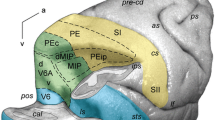Abstract
A monkey (Macaca nemestrina) was trained to perform a behavioral program consisting of the selection and execution of a defined sequence of actions according to a visual conditioned signal. Discriminant analysis was used to evaluate the parameters of the collective activity of six simultaneously recorded putamen neurons. The collective activity of the neurons showed significant differences associated with execution by the monkey of left- and right-sided tasks. These differences were seen to be quite consistent in different groups of neurons. Despite the fact that putamen neurons were involved in the performance of nine separately analyzed fragments of the program, differences, were seen in two of these: at the moment of taking the decision relating to the direction of movement, and after its completion when a signal indicating the completed result was presented, independently of whether the animal selected the side for the action correctly or incorrectly. In the case of erroneous decisions, the response mosaic differed from that obtained for correct decisions; however, differences due to previously taken decisions regarding the side of action were preserved. These differences were greater at the point of program completion than at the moment of deciding the direction of movement.
Similar content being viewed by others
References
I. F. Kalmykov and A. A. Orlov, “A multichannel microelectrode system for long-term use,” Fiziol. Zh. im. I. M. Sechenova,80, No. 8, 25–27 (1994).
G. A. Kulikov, L. V. Cherenkova, and S. N. Perfil'ev, “Cortical mechanisms of the programming action of the brain in organizing behavioral acts in cats,” Fiziol. Zh. im. I. M. Sechenova,81, No. 8, 165–168 (1995).
A. A. Orlov and B. P. Mochenkov, “Training monkeys to complex behavioral tasks,” Zh. Vyssh. Nerv. Deyat.,43, No. 5, 869–877 (1993).
A. A. Orlov, B. F. Tolkunov, S. V. Afanas'ev, and I. F. Kalmykov, “Reflection of internal and external behavioral determinants in the neuronal activity of the monkey neostriatum,” Fiziol. Zh. im. I. M. Sechenova,80, No. 1, 9–16 (1994).
A. A. Orlov, V. I. Shefer, and B. P. Mochenkov, “A miniature multichannel micromanipulator for the independently moving microelectrodes in bundles,” Fiziol. Zh. SSSR,75, No. 9, 1275–1278 (1989).
B. F. Tolkunov, “Principles of identifying the function of a nerve center (using the mammalian neostriatum as an example),” Zh. Évolyuts. Biokhim. Fiziol.,27, No. 5, 598–607 (1991).
B. F. Tolkunov, “Functional linkage between the mechanisms for selecting significant signals and their resulting motor responses,” Zh. Vyssh. Nerv. Deyat.,42, No. 5, 867–875 (1992).
B. F. Tolkunov, A. A. Orlov, and S. V. Afanas'ev, “Models of the functions of the neostriatum and the activity of its neurons during behavior in monkeys,” Fiziol. Zh. im. I. M. Sechenova,81, No. 1, 12–20 (1995).
B. F. Tolkunov, A. A. Orlov, and S. V. Afanas'ev, “The activity of striatum neurons in the monkey brain during simultaneously performed actions,” Fiziol. Zh. im. I. M. Sechenova,81, No. 8, 121–127 (1995).
B. F. Tolkunov, A. A. Orlov, and B. F. Mochenkov, “Neostriatal neuron activity in the monkey during operant behavior,” Neirofiziologiya1, No. 2, 132–140 (1993).
B. F. Tolkunov and V. V. Menshutkin, “Responses of a model neuronal network with stochastic connections to changes in the frequency and interval structure of input signals,” Biofizika,40, No. 6, 1313–1319 (1995).
G. E. Alexander and M. R. DeLong, “Microstimulation of the primate neostriatum. II. Somatotopic organization of striatal microexcitable zones and their relation to neuronal response properties,” J. Neurophysiol.,53, No. 6, 1417–1430 (1985).
A. R. Cools, R. Jaspers, M. Schwarz, K. H. Sontag, M. Vrijmoed-de Vries, and N. Wilcock, “Basal ganglia and switching motor programs,” in: The Basal Ganglia, J. S. McKenzie, R. E. Kemm, and L. N. Wilcock (eds.), London (1984).
M. D. Crutcher and M. R. DeLong, “Single cell studies of the primate putamen. 1. Functional organization,” Exp. Brain Res.,53, No. 2, 233–243 (1984).
P. M. Gochin, M. Colombo, G. A. Dorfman, G. L. Gerstein, and C. G. Gross “Neural ensemble coding in inferior temporal cortex,” J. Neurophysiol,71, No. 6, 2325–2337 (1994).
S. L. Liles, “Activity of neurons in putamen during active and passive movements of wrist,” J. Neurophysiol.,53, No. 1, 217–236 (1985).
C. D. Marsden, “What do the basal ganglia tell premotor cortical areas?,” in: Motor Areas of the Cerebral Cortex, Chichester, New York-Brisbane-Toronto, Singapore (1987).
E. T. Rolls, “Responses of neurons in different regions of the striatum of the behaving monkey,” in: The Basal Ganglia, J. S. McKenzie, R. E. Kemm, and L. N. Wilcock (eds.), London (1984).
R. Romo and W. Schultz, “Neuronal activity preceding self-initiated or externally timed arm movements in area 6 of monkey cortex,” Exp. Brain Res.,67, No. 3, 656–662 (1987).
S. A. Snider and J. C. Lee, A Stereotaxic Atlas of the Monkey Brain (Macaca mulata), Chicago (1961).
J. Tanji, and K. Shima, “Role for supplementary motor area cells in planning several movements ahead,” Nature,371, No. 6496, 413–416 (1994).
M. C. Vrijmoed-de Vries and A. R. Cools, “Further evidence for the role of the caudate nucleus in programming motor and nonmotor behaviour in java monkeys,” Exp. Neurol.,87, No. 1, 58–85 (1985).
Additional information
Laboratory for the Integrative Functions of the Brain, I. M. Sechenov Institute of Evolutionary Biochemistry and Physiology, Russian Academy of Sciences, 44 M. Torez Prospekt, 194223 St. Petersburg, Russia. Translated from Rossiiskii Fizidogicheskii Zhurnal imeni I. M. Sechenova, Vol. 83, No. 1–2, pp. 19–27, January–February, 1997.
Rights and permissions
About this article
Cite this article
Afanas'ev, S.V., Tolkunov, B.F., Orlov, A.A. et al. Collective responses of neostriatal (putamen) neurons during alternative behavior in monkeys. Neurosci Behav Physiol 28, 231–237 (1998). https://doi.org/10.1007/BF02462951
Received:
Revised:
Issue Date:
DOI: https://doi.org/10.1007/BF02462951



